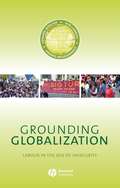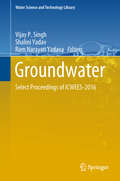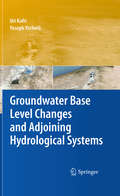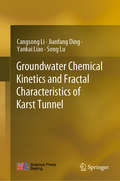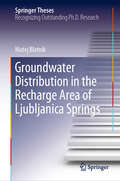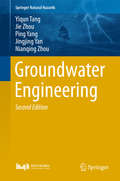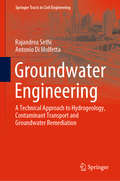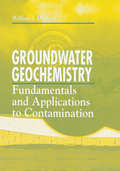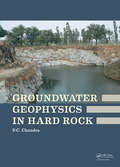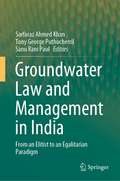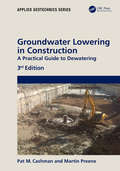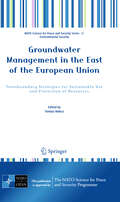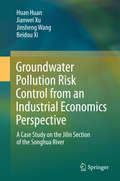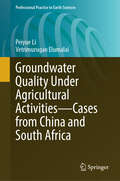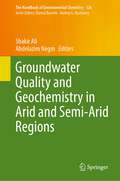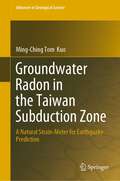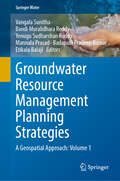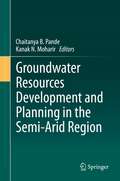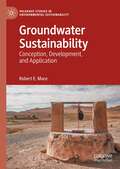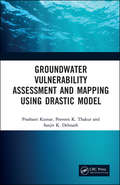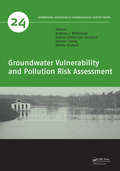- Table View
- List View
Grounding Globalization: Labour in the Age of Insecurity (Antipode Book Series #42)
by Rob Lambert Andries Beziudenhout Edward Webster*Winner of the 2009 Distinguished Scholarly Monograph Prize, awarded by the American Sociological Association Labor and Labor Movements section* Claims have been made on the emergence of a new labour internationalism in response to the growing insecurity created by globalization. However, when persons face conditions of insecurity they often turn inwards. The book contains a warning and a sign of hope. Some workers become fatalistic, even xenophobic. Others are attempting to globalize their own struggles. Examines the claim that a new labour internationalism is emerging by grounding the book in evidence, rather than assertion Analyzes three distinct places – Orange, Australia; Changwon, South Korea; and Ezakheni, South Africa – and how they dealt with manufacturing plants undergoing restructuring Explores worker responses to rising levels of insecurity and examines preconditions for the emergence of counter-movements to such insecurities Highlights the significance of 'place' and 'scale', and demonstrates how the restructuring of multi-national corporations, and worker responses to this, connect the two concepts
Groundwater
by Vijay P. Singh Shalini Yadav Ram Narayan YadavaThis book comprises the select proceedings of the International Conference on Water, Environment, Energy and Society. The book is divided into three parts. The first part deals with some aspects of groundwater focusing on delineation of groundwater zones, spatio-temporal variability of groundwater, and aquifer vulnerability. The second part is on some aspects of groundwater recharge, dealing with recharge sources, management of recharge and recharge technology, change of land use / land cover on groundwater recharge. The concluding part covers groundwater quality, encompassing causes and sources of pollution, leachate migration, river bank filtration, variability of quality, assessment and management of quality. The book will be of interest to researchers and practitioners in the field of water resources, hydrology, environmental resources, agricultural engineering, watershed management, earth sciences, as well as those engaged in natural resources planning and management. Graduate students and those wishing to conduct further research in water and environment and their development and management will also find the book to be of value.
Groundwater Base Level Changes and Adjoining Hydrological Systems
by Uri Kafri Yoseph YechieliThe proposed book deals with the role of changing groundwater base level on the adjacent hydrological systems. It summarizes, compiles and compares results of current and paleo base levels, using examples from all over the world. A classification is given for marine or continental groundwater base levels with special attention to those below sea level. The factors controlling base level changes and the methods for their determination are elaborated. Holocene and future changes are discussed with their effect on salinization and flushing mechanisms of groundwater. All topics described in the book are accompanied by examples and references from all over the world.
Groundwater Chemical Kinetics and Fractal Characteristics of Karst Tunnel
by Cangsong Li Jianfang Ding Yankai Liao Song LuThe key to the solution of geological hazards such as Karst water inrush and mud burst in tunnel lies in the accurate prediction or detection of Karst and groundwater. By means of on-site monitoring, theoretical analysis and indoor simulation experiments, the authors conduct in-depth research on the characteristics of water-bearing media and their mechanism of action, and explored the relevance of "Karst morphology", "Karst groundwater" and "fractal characteristics". An evaluation model of Karst development degree based on hydrochemical kinetic parameters and fractal index of Karst morphology is established. Based on the combination of Karst groundwater dynamics, hydrochemistry, water-rock interaction theory and fractal theory, the hydrochemical Kinetics and fractal index evaluation technique for Karst development is proposed. It provides a new theory and method for improving the accuracy of Karst and groundwater forecasting. The research results are of practical and guiding significance to the construction, Karst geological disasters prevention and management of various underground projects in Karst areas. Engineers and technicians, hydrogeological engineering geologists, and college students engaged in tunnel and underground engineering will find it valuable.
Groundwater Development and Management: Issues And Challenges In South Asia
by Pradip K. SikdarThis book deals with the challenges for efficient groundwater management, with a focus on South Asia and India, providing a balanced presentation of theory and field practice using a multidisciplinary approach. Groundwater of South Asia is increasingly confronted with overuse and deteriorating quality and therefore requires urgent attention. Management of the stressed groundwater systems is an extremely complex proposition because of the intricate hydrogeological set-up of the region. Strategies for sustainable management must involve a combination of supply-side and demand-side measures depending on the regional setting and socio-economic situations. As a consequence, the challenges of efficient groundwater management require not only a clear understanding of the aquifer configuration, but also demand for the development of a comprehensive database of the groundwater occurrences and flow systems in each hydrogeological setting. In addition, drilling and well construction methods that are appropriate to different hydrogeological formations need to be implemented as well as real-time monitoring of the status of the groundwater use. Also corrective measures for groundwater that is threatened with depletion and quality deterioration need to be installed. Finally, the legal framework of groundwater needs to be rearticulated according to the common property aspect of groundwater. These challenges should revolve around effective groundwater governance by creating an atmosphere to support and empower community-based systems of decision-making and revisit the existing legal framework and groundwater management institutions by fostering community initiatives.This book is relevant for academics, professionals, administrators, policy makers, and economists concerned with various aspects of groundwater science and management.
Groundwater Distribution in the Recharge Area of Ljubljanica Springs (Springer Theses)
by Matej BlatnikThis book presents a novel approach to studying the groundwater dynamics of and characterising karst aquifers. The content is based on long-term monitoring of groundwater parameters in the epiphreatic caves of a selected karst aquifer: part of the classical recharge area of Ljubljanica River, Slovenia. The recorded data was analysed on the basis of the recharge to the system, which is controlled by outflow from the Planinsko Polje, and on the basis of the known and inferred geometry of the karst conduit system. The book presents numerically tested conceptual models of the observed conduit system, which offer new insights into its structure and function. In closing, the author stresses the importance of caves as groundwater monitoring sites and provides new tools for interpreting cave water level hydrographs. Although the book focuses on a specific site, the methodology introduced here can be applied to numerous other karst systems, lending it considerable practical relevance.
Groundwater Engineering
by Ping Yang Jingjing Yan Yiqun Tang Jie Zhou Nianqing ZhouIntegrating information from several areas of engineering geology, hydrogeology, geotechnical engineering, this book addresses the general field of groundwater from an engineering perspective. It covers geological engineering as well as hydrogeological and environmental geological problems caused by groundwater engineering. It includes 10 chapters, i. e. , basic groundwater theory, parameter calculation in hydrogeology, prevention of geological problem caused by groundwater, construction dewatering, wellpoint dewatering methods, dewatering wells and drilling, groundwater dewatering in foundation-pit engineering, groundwater engineering in bedrock areas, numerical simulation in groundwater engineering, groundwater corrosion on concrete and steel. Based on up-to-date literature, it describes recent developments and presents several case studies with examples and problems. It is an essential reference source for industrial and academic researchers working in the groundwater field and can also serve as lecture-based course material providing fundamental information and practical tools for both senior undergraduate and postgraduate students in fields of geology engineering, hydrogeology, geotechnical engineering or to conduct related research.
Groundwater Engineering (Springer Environmental Science and Engineering)
by Ping Yang Jingjing Yan Yiqun Tang Jie Zhou Nianqing ZhouIntegrating information from several areas of engineering geology, hydrogeology, geotechnical engineering, this book addresses the general field of groundwater from an engineering perspective. It covers geological engineering as well as hydrogeological and environmental geological problems caused by groundwater engineering. It includes 10 chapters, i.e., basic groundwater theory, parameter calculation in hydrogeology, prevention of geological problem caused by groundwater, construction dewatering, wellpoint dewatering methods, dewatering wells and drilling, groundwater dewatering in foundation-pit engineering, groundwater engineering in bedrock areas, numerical simulation in groundwater engineering, groundwater corrosion on concrete and steel. Based on up-to-date literature, it describes recent developments and presents several case studies with examples and problems. It is an essential reference source for industrial and academic researchers working in the groundwater field and can also serve as lecture-based course material providing fundamental information and practical tools for both senior undergraduate and postgraduate students in fields of geology engineering, hydrogeology, geotechnical engineering or to conduct related research.
Groundwater Engineering: A Technical Approach to Hydrogeology, Contaminant Transport and Groundwater Remediation (Springer Tracts in Civil Engineering)
by Rajandrea Sethi Antonio Di MolfettaThis textbook employs a technical and quantitative approach to explain subsurface hydrology and hydrogeology, and to offer a comprehensive overview of groundwater-related topics such as flow in porous media, aquifer characterization, contaminant description and transport, risk assessment, and groundwater remediation. It describes the characterization of subsurface flow of pristine and polluted water and provides readers with easily applicable tools for the design of water supply systems, drinking-water source protection, and remediation interventions. Specific applications range from groundwater exploitation as a drinking water supply to the remediation of contaminated aquifers, from the definition and safeguarding of drinking-water sources to the assessment of human health risks in connection with groundwater contamination events. The book represents an ideal learning resource for upper-undergraduate and graduate students of civil engineering, environmental engineering, and geology, as well as practitioners in the fields of water resource management and environmental protection who are interested in groundwater engineering and technical hydrogeology.
Groundwater Geochemistry: Fundamentals and Applications to Contamination
by Randy Siegel William J. DeutschGroundwater Geochemistry: Fundamentals and Applications to Contamination examines the integral role geochemistry play s in groundwater monitoring and remediation programs, and presents it at a level understandable to a wide audience. Readers of all backgrounds can gain a better understanding of geochemical processes and how they apply to groundwater systems.The text begins with an explanation of fundamental geochemical processes, followed by a description of the methods and tools used to understand and simulate them. The book then explains how geochemistry applies to contaminant mobility, discusses remediation system design, sampling program development, and the modeling of geochemical interactions. This clearly written guide concludes with specific applications of geochemistry to contaminated sites.This is an ideal choice for readers who do not have an extensive technical background in aqueous chemistry, geochemistry, or geochemical modeling. The only prerequisite is a desire to better understand natural processes through groundwater geochemistry.
Groundwater Geophysics in Hard Rock
by Prabhat Chandra ChandraIn hard rock terrain, shallow water wells generally have a poor to moderate yield. Sinking wells deeply to tap yielding fracture zones often backfires, because the borehole may miss the saturated fracture zones at depths. A wrong approach to groundwater exploration in hard rock has therefore often led to unnecessary recurring expenditures and waste
Groundwater Law and Management in India: From an Elitist to an Egalitarian Paradigm
by Sarfaraz Ahmed Khan Tony George Puthucherril Sanu Rani PaulThis book presents a comprehensive analysis of the existing nature of India’s groundwater laws. In the backdrop of the gravity of groundwater crisis that threatens to engulf the country, the book examines the correlation between the imperfections in the law and water crisis and advocates a reform agenda to overhaul the legal framework. It accomplishes this objective by examining how some of the States and Union Territories regulate and manage groundwater through the legal instrumentality against the backdrop of the two conflicting paradigms: the “elitist” and the “egalitarian.” The book’s fundamental premise is that despite being an extraordinarily critical resource that supports India’s burgeoning population’s ever-increasing water demands, groundwater is abused and mismanaged. The key argument that it posits is that the elitist paradigm must give way to an egalitarian one where groundwater is treated as a common property resource. To place this message in perspective, the book’s introduction explains the dichotomy between the two paradigms in the context of groundwater. This sets the stage, after which the book is divided thematically into three parts. The first part deals with some of the general groundwater management concerns brought to the fore by the operation of the elitist paradigm. Since water is constitutionally a State subject, the second part analyses the groundwater legislations of different States and Union Territories set against their unique circumstances. As these laws do not dismantle the elitist paradigm that interlocks groundwater rights to land rights, the next part articulates the legal reform agenda where a case is made to re-engineer groundwater laws to reflect a more sustainable basis. The findings and arguments resonate with the situation in many developing countries around the world due to which the book is a valuable resource for researchers across disciplines studying this area, and also for policy makers, think tanks, and NGOs.Groundwater Management–Inter-state Water Conflicts–Aquifers–Water Markets–Water Security–Water Law Reform–Groundwater Law–Water Law–Sustainable Development–Hydrology
Groundwater Lowering in Construction: A Practical Guide to Dewatering
by Martin Preene Pat M. CashmanPraise for the Second Edition: "This is the book that the dewatering sector really needs – it is reliably based on sound theory and profound understanding of the physical processes, yet is presented in a very accessible and user-friendly manner. It draws on many, many decades of experience, and yet is utterly up to date. . . . It is a one-stop shop for the dewatering practitioner – who can nonetheless rest assured that the theoretical basis of the methods presented is flawless."— Professor Paul L. Younger, FGS, FICE, C.Geol., C.Eng., FREng, University of Glasgow, Scotland, UK "The best reference on this topic available . . . and will prove useful to a wide variety of readers ranging from junior construction engineers or dewatering contractors to theoretical hydrogeologists and environmental managers. It is rare that a book is able to bridge the gap between theoretical design guidance and practical application." — S.N. Sterling, University of Waterloo, Canada The extensively updated Groundwater Lowering in Construction: A Practical Guide to Dewatering, 3rd Edition offers practical advice on all phases of groundwater control systems, from planning and design, through installation and maintenance, and ultimately decommissioning. The expertise provided in this book can help you improve working conditions, increase project viability, save time and reduce excavation costs. Designers and managers of construction and engineering projects are given the tools necessary to effectively control groundwater. The content is divided into three sections – Principles, Design and Construction. The Principles section explains the fundamentals of groundwater flow as it relates to civil engineering excavations. The Design section explores in extensive detail site investigation, permeability assessment methods and groundwater control strategies. Chapters in the Construction section describe dewatering and exclusion techniques, and examine the complete life cycle of a groundwater control scheme, including monitoring, maintenance and decommissioning. This section incorporates eleven case histories from the authors’ casebook. The 3rd edition has been greatly revised and updated, and contains more than 200 new illustrations. The new content covers: Permeability of soils and rocks Groundwater problems for excavations in rock Groundwater control for tunnelling projects, such as shafts and cross passages Methods for assessing permeability Decommissioning of dewatering systems Optimisation of groundwater control schemes. The new, expanded content offers valuable direction that can give you a true competitive advantage in the planning and execution of temporary and permanent dewatering works for excavation and tunnelling. Written for practising engineers, geologists and construction managers, as well as postgraduate engineering students, this revamped manual on design and practice presents numerous case studies and extensive references to enhance understanding. Martin Preene is a groundwater consultant, based in the UK. He has more than 30 years’ experience working on dewatering and groundwater control projects worldwide.The late Pat Cashman was the leading British exponent of groundwater control for his generation, championing a practical and straightforward approach for more than forty years.
Groundwater Management in the East of the European Union
by Tomasz NaleczThis volume is the result of work carried out under the NATO SPS Study Pilot Project "Sustainable Use and Protection of Groundwater Resources - Transboundary Water Management." It contains basic information on hydrogeological conditions, groundwater management and monitoring in areas of the Belarus, Lithuanian, Polish and Ukrainian borders, simultaneously borders of the European Union with its eastern partners. In view of the importance of the rational utilization of groundwater reserves, which is essential for our future existence, the book presents recommendations for a united methodology of an integrated groundwater monitoring system in this transnational area. The contributions also cover environmental and surface water issues that have direct effects on groundwater resources. The financial dimension of resource mobilization for environmental projects in Eastern Europe also features as part of a complex project solution.
Groundwater Pollution Risk Control from an Industrial Economics Perspective: A Case Study On The Jilin Section Of The Songhua River (SpringerBriefs in Environmental Science)
by Beidou Xi Huan Huan Jianwei Xu Jinsheng WangThis book argues that groundwater pollution risk assessment is the essential foundation of groundwater pollution prevention and control. It is on this basis that economic leverage is used to make new breakthroughs in groundwater protection and governance. Presenting a case study on the Jilin Section of the Songhua River, the book applies the overlay index method to assess the shallow groundwater pollution risk and identify high-risk areas and major pollution sources in an effort to identify the mechanism of interaction between industrial structures and groundwater pollution. Further, it proposes concrete measures for preventing and controlling groundwater pollution from an industrial economics perspective. As such, the book offers a valuable resource for all graduate students, lecturers and researchers who are interested in learning about resources and environmental economics.
Groundwater Prospecting and Management
by H. P. Patra Shyamal Kumar Adhikari Subrata KunarThe book provides an elaborate treatment of groundwater prospecting and management covering remote sensing, geological-geophysical cum hydrogeological studies, exploration (geological and geophysical), development (well logging techniques, pump test, its analysis and applications in well design), contamination (pollution of groundwater) and regulatory legislations regarding groundwater utilization under one cover. The book presents an elucidation of fundamental and theoretical background of each technique supported by necessary illustrative examples and exclusive case studies. It is a text-cum-reference book not only for students, research scholars and practicing earth scientists but also for practicing civil and agricultural engineers working in the application of groundwater resources, engaged in its exploration, development, contamination, legislation and management. The general readers can also refer the book for understanding the groundwater domain for adequate knowledge, as groundwater resources are essential life support commodity which is replenishable but not inexhaustible.
Groundwater Quality Under Agricultural Activities—Cases from China and South Africa (Professional Practice in Earth Sciences)
by Peiyue Li Vetrimurugan ElumalaiThis insightful book, based on the investigation results of a collaboration project between China and South Africa supported by NSFC and NRF, offers a detailed exploration of the impacts of agricultural activities on groundwater quality. It provides an in-depth understanding of the hydrogeochemical characteristics of groundwater, the assessment of groundwater quality, and the intricacies of groundwater pollution. The book further delves into the effects of land use and land cover changes on groundwater pollution, presenting a comprehensive overview of human activities and their impacts on water resources. The book also presents a meticulous health risk assessment of groundwater contaminants, providing valuable insights for a range of readers, from public health officials to environmental scientists and policymakers. It outlines robust strategies for groundwater quality protection and management. The discussion on the hydrochemical evolution of groundwater contributes to a more holistic understanding of groundwater systems. This book is an essential resource for researchers, students, professionals in environmental science, hydrology, water resource management, policymakers, and public health officials. Its blend of theoretical knowledge and practical solutions serves as a guide for those aiming to protect and improve groundwater quality in the face of agricultural activities and climate change.
Groundwater Quality and Geochemistry in Arid and Semi-Arid Regions (The Handbook of Environmental Chemistry #126)
by Abdelazim Negm Shakir AliThis book reviews groundwater quality and its major global contaminants, and collects the latest advances in the analysis, remediation, risk assessment, and hydrogeochemistry of groundwater in countries such as Algeria, Egypt, Ghana, Kazakhstan, Morocco, Saudi Arabia, and the USA. This book mainly focuses on the major arid and semi-arid areas where groundwater is scarce and highly polluted with geogenic and anthropogenic contaminants and the recharge to the groundwater is negligible due to limited rainfall. Divided into 2 parts, the book starts by covering topics like assessment and protection of groundwater in arid and semi-arid regions, groundwater pollution, and contamination risk assessment. Particular attention is given to the application of environmental isotopes in groundwater studies and how anthropogenic activities impact groundwater quality, the impact of irrigation reservoirs in groundwater and soil quality, and how artificial intelligence is applied to forecast groundwater quality. In the second part of this book, readers will find more about the major global contaminants of groundwater in arid and semi-arid areas, including a geochemical analysis of fluoride and nitrate contamination. Supported by regional case studies, this book appeals to researchers, scholars, and professionals working in the field of groundwater contamination and remediation and is also an important account for policymakers.
Groundwater Radon in the Taiwan Subduction Zone: A Natural Strain-Meter for Earthquake Prediction (Advances in Geological Science)
by Ming-Ching Tom KuoThis book presents the mechanism of in-situ radon volatilization and outlines the geological requisites to site a radon monitoring well for earthquake warning. A small fractured aquifer under undrained conditions is an effective natural strain meter for earthquake prediction. It shows significant merit on a local basis, and most importantly, the analysis can also be applied globally in subduction zones with similar tectonic settings and physical–chemical relationships.Between 2003 and 2010, anomalous declines in groundwater radon concentration were recurrently recorded at Antung, Taiwan, which are considered as precursory to local major earthquakes. The correlations between radon decline and earthquake magnitude are useful for early warning of local main earthquakes. The book consists of 7 chapters. Chapter 1 presents background information and the objectives of the book. Chapter 2 illustrates the methods of monitoring groundwater radon and a brief review of earthquake prediction research using groundwater radon. Chapter 3 provides the details of anomalous decrease in groundwater radon before the Taiwan Mw 6.8 Chengkung Earthquake of 2003. Chapter 4 provides the description of the mechanism of groundwater-radon volatilization. Chapter 5 shows the recurrent anomalous declines in groundwater radon concentration consistently recorded at Antung, Taiwan, prior to local main earthquakes that occurred between 2003 and 2010. Monitoring groundwater radon in small, unconfined fractured aquifers is explained in Chapter 6, followed by an analysis of correlating precursory declines in groundwater radon, precursory time with earthquake magnitudes for small, confined fractured aquifers in Chapter 7.
Groundwater Resource Management Planning Strategies: A Geospatial Approach: Volume 1 (Springer Water)
by Etikala Balaji Vangala Sunitha Bandi Muralidhara Reddy Yenugu Sudharshan Reddy Mannala Prasad Badapalli Pradeep KumarGeospatial tools to Groundwater Resources explain the most recent methods in Geographic Information Systems (GIS) and geostatistics as they apply to groundwater through complete case studies that demonstrate actual remote sensing applications in this field. Due to the rising demand for water, its decreasing quality, and its limited supply, water resource management has grown to be a serious issue. In many places of the world, groundwater is the main supply of fresh water, but certain areas are growing unduly reliant on it, utilising groundwater more quickly than it can be replenished naturally and resulting in an unceasing decrease in water tables. For the efficient use, management, and modelling of this priceless but diminishing natural resource, systematic planning of groundwater consumption using current approaches is crucial. Remote sensing, GIS, GPS (Global Positioning Systems), and geostatistical approaches are among the effective water management methods that have developed with the introduction of powerful and fast personal computers. Now more than ever, it is possible to analyse with greater accuracy the relationships between environmental elements and human health and wellbeing. Our understanding of the continuum between environment and health consequences on many different sizes, from the global to even the individual, has evolved thanks to a number of transdisciplinary accomplishments. This book covers a wide range of geospatial health-related topics and methods, including climate change, healthcare utilisation, health disparities, air quality assessment, asthma, water quality assessment, and machine learning. It also advances scientific understanding, development, and application of geospatial technologies related to water resource management. Researchers and postgraduate students in Earth and Environmental Sciences, particularly GIS, agriculture, hydrology, natural resources, and soil science, who need to be ableto apply the most recent innovations in groundwater research in a practical way will find Case Studies in Geospatial Applications to Groundwater Resources to be a valuable resource. This edited volume will concentrate on the most recent studies and uses of geospatial methods in water resource management, offering insights into the difficulties and possibilities of applying these methods to solve practical issues.
Groundwater Resources Development and Planning in the Semi-Arid Region
by Chaitanya B. Pande Kanak N. MoharirThis book addresses the various challenges in achieving sustainable groundwater development, management, and planning in semi-arid regions, with a focus on India, and discusses advanced remote sensing and GIS techniques for the estimation and management of groundwater resources. The book is timely as there is a need for a better understanding of the various tools and methods required to efficiently and sustainably meet the growing demand for clean surface and groundwater in developing countries, and how these tools can be combined with other strategies in a multi-disciplinary fashion to achieve this goal in water-scarce regions. To wit, the book combines remote sensing and GIS techniques, runoff modeling, aquifer mapping, land use and land cover analyses, evapotranspiration estimation, crop coefficients, and water policy approaches. This will be of use to academics, policymakers, social scientists, and professionals involved in the various aspects of sustainable groundwater development, planning, and management.
Groundwater Sustainability: Conception, Development, and Application (Palgrave Studies in Environmental Sustainability)
by Robert E. MaceThis book will provide a comprehensive discussion of groundwater sustainability, including what it is, how its definition has changed over time, why traditional assessments of it are wrong, how assessments of it are ideally multidisciplinary efforts recognizing that policy is more controlling of outcomes than science, and why achieving it is difficult once pumping exceeds sustainable levels of pumping. The book will provide a nontechnical background of hydrogeology relevant to groundwater sustainability and present several case studies from around the United States and the world. The book has been designed to appeal to academics, students, and practitioners. Academics, particularly those just getting into the subject, will find the book a useful entry in terms of management concepts and political realities of attempting to achieve groundwater sustainability. It will also be useful to academics in that the book will include discussions on the history and development of groundwater sustainability and the practical aspects of aspiring to and achieving sustainable production. Although not a textbook, the book could be used as the basis for teaching a course or as a supplement to a hydrogeology or groundwater management class. Accordingly, the book will include questions and additional reading materials at the end of each chapter. This book will also be useful to practitioners through non-technical explanations of the sciences, discussions of the nuances of defining sustainability in aquifers, and the presentation of case studies where sustainable management has failed and succeeded.
Groundwater Vulnerability Assessment and Mapping using DRASTIC Model
by Prashant Kumar Praveen Thakur Sanjit DebnathThis book shows the effectiveness of DRASTIC model in a geographical setting for validation of vulnerable zones and presents the optimization of parameters for the development of precise maps highlighting several zones with varied contamination. Impact of vadose zone has also been assessed by considering every sub-surface layer. Exclusive title covering effectiveness of DRASTIC model for groundwater vulnerability assessment Reviews of the strengths and limitations of assessment methods Presents multi-criteria evaluation of hydro-geological and anthropogenic factors Discusses integration with geographic information system (GIS) and remote sensing (RS) Includes application of groundwater governance framework with a case study study of a geographical setting
Groundwater Vulnerability and Pollution Risk Assessment (IAH - Selected Papers on Hydrogeology #24)
by Andrzej J. Witkowski Sabina Jakóbczyk-Karpierz Joanna Czekaj Dorota GrabalaThis volume contains 15 selected papers presented at two IAH conferences which were held in Ustroń, Poland in 2015 ("Groundwater Vulnerability - From Scientific Concept to Practical Application" ) and in 2018 ("New Approaches to Groundwater Vulnerability"). The contents of the book is divided in four main parts. In addition to the comparison and validation of different methods of groundwater vulnerability (DRASTIC, GOD, PI, RTt, AVI, SINTACS, COP) the book contains new interesting aspects of vulnerability assessment regarding, for example, evaluation of coastal aquifer vulnerability and aquifer vulnerability to methane gas leakage from shale gas wells. The book also contains the results of studies on factors affecting intrinsic and specific vulnerability assessment (migration of antibiotics and nitrate, groundwater-surface water interaction). An interesting aspect of the book are examples of the different national approaches to groundwater vulnerability mapping (Poland, Ireland, Italy). The book will be very useful for hydrogeologists interested in groundwater vulnerability, experts interested in risk assessment, environmentalists, land use planners, water managers, employees of companies from the environmental industry, regional and local environmental protection councils, and students.
Groundwater Vulnerability: Chernobyl Nuclear Disaster
by Boris Faybishenko Alexander Bohuslavsky Volodymir Bublias Thomas J. Nicholson Vyacheslav ShestopalovThe Chernobyl Nuclear Power Plant (NPP) disaster that occurred in Ukraine on April 26, 1986, was one of the most devastating in human history. Using this as a case study, the AGU monograph Groundwater Vulnerability: Chernobyl Nuclear Disaster is devoted to the problem of groundwater vulnerability, where the results of long-term field and modeling investigations of radionuclide transport in soil and groundwater, within the Ukrainian part of the Dnieper River basin (Kyiv region of Ukraine), are discussed. The authors provide a comprehensive review of existing literature on the assessment of groundwater vulnerability and then describe an improved methodology, which is developed based on integration of the methods of hydrogeological zonation and modeling of anomalously fast migration of radioactive contaminants from the land surface toward groundwater. This volume also includes the evaluation of the effect of preferential and episodic flow on transport of radionuclides toward the aquifers and risk assessment of groundwater vulnerability, which can further assist future researchers in developing remediation technologies for improving drinking water quality. Further, this volume sheds light on the consequences of groundwater contamination from nuclear disasters and assists with assessing the risks associated with contamination and developing effective remediation technologies. Volume highlights include discussions of the following: - Assessment of groundwater vulnerability to contamination from the Chernobyl nuclear disaster - Novel analytical results of the 25-year investigations of groundwater contamination caused by Chernobyl-born radionuclides - The wealth of data on different modes of radioactive transport in the atmosphere, water, and soils, and along the food chains - The hydrogeological and physico-chemical processes and factors in groundwater contaminated zones - The applicability of commonly used methods of the evaluation of groundwater vulnerability - A unique method of fluid dynamics that involves an anomalously fast migration of contaminants through zones of preferential flow from the land surface toward groundwater - Building confidence in the assessment of migration pathways of radionuclides in the biosphere - Assessment and prediction of the consequences of the nuclear accident, which can shed light on protection from global nuclear accidents - Analogue information for different nuclear waste disposal and environmental projects around the world
